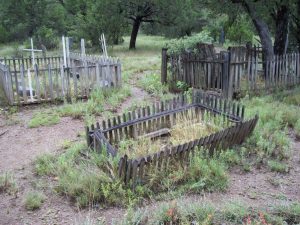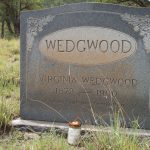 Cemeteries have always fascinated me. No, that’s not weird–that’s history! Here’s a glimpse into the story of the old Kingston Cemetery dating from the silver mining days of Kingston, New Mexico near Hillsboro and not far from Las Cruces. I encourage you to take a stroll through here sometime and imagine all the lives and stories that went before.
Cemeteries have always fascinated me. No, that’s not weird–that’s history! Here’s a glimpse into the story of the old Kingston Cemetery dating from the silver mining days of Kingston, New Mexico near Hillsboro and not far from Las Cruces. I encourage you to take a stroll through here sometime and imagine all the lives and stories that went before.
This article originally appeared in the Desert Exposure Magazine (April 2012)
History in Headstones: Kingston Cemetery
We have come to the Black Range to camp, a two day respite from the dailiness of life in the valley, to reconnect. It is a good trip. I’ve never seen the mountains like this before. We’ve had so much rain this summer and frequent “clouding in” this weekend. Peaks and passes float isolated in the clouds. Gray streamers weave their way through the mountain valleys and canyons like some elaborate ribbon dance. I catch at old memories, grasping at some, pushing others away; they tangle, separate and come together again, weaving in and out of the mist. Descending the road to the old mining town of Kingston we catch glimpses of hidden places and side roads, beckoning like something half-remembered.
The Kingston Cemetery crouches comfortably in the foothills of the Black Range, graceful in its spareness. No artificial flowers here, the people of these mountain families find beauty in the light and the granite and the hot smell of the juniper that has slowly grown here for lifetimes. We start together as we enter the cemetery gate, wondering aloud at the lives we see marked here. Most of the tombstones are being reclaimed, weathered by wind, sandstorms, mountain rain and the soft aging of decades that blurs the features, crumbles the granite to fine gravel under the trees in this harsh garden. A different kind of beauty here, scored by the names of men and women and so many young ones who never reached those milestones.
We are fascinated by the etched dates marking their brief lives. Stopping in gratitude at the graves of a World War Two lieutenant and a soldier from a generation before, the first great war that should have ended all others, we render thanks for service given. We walk and ponder the hard lives of the people who ranched and mined, gardened and raised children, loved and got drunk sometimes and yelled and cried and died. Wandering the serpentine paths among the graves, our eyes are first drawn to one, then another, till we gradually become separated, out of reach of each other’s voice for a time, lost in our own thoughts, then coming back together where the paths cross. Asking, “Oh did you see that one, come here you’ve got to see, guess what I’ve found, you’ll never believe, oh, look how long she lived.” The comfortableness of a long marriage, able to go and explore and come back together, trusting that we will find each other again, calm in the separateness, rejoicing in the together.
 I explore the far corners of the cemetery looking for the stories of those on the fringes. Curiously, I find no markers out there, no headstones, no rock rings defining a resting place, no ornamental fence or even a beaten and weathered wood cross. Could be this western town more tolerantly incorporated its citizens in their final resting places. Or perhaps they are just forgotten by all but the mountains standing watch in the purple evening light.
I explore the far corners of the cemetery looking for the stories of those on the fringes. Curiously, I find no markers out there, no headstones, no rock rings defining a resting place, no ornamental fence or even a beaten and weathered wood cross. Could be this western town more tolerantly incorporated its citizens in their final resting places. Or perhaps they are just forgotten by all but the mountains standing watch in the purple evening light.
There is one more tombstone I haven’t looked at yet. I have purposely saved it for last, circling around it, wondering but delaying the knowing. I have been this way since childhood; the anticipation is a great measure of the pleasure. It is a lady’s; at its base is a glass canning jar with a piece of wide-ruled notebook paper folded up inside. It is written in crayon. Neither the note or the glass have started to yellow. The white granite tombstone reads “Wedgwood” and I spend the drive home wondering about her and watching the mountains in the rearview mirror.

Wherever the places you explore this summer, I hope they spark your imagination and make you wonder.
Karen
 Ah, June—the month for weddings! Odds are you married in the summer or you know someone who did. This is a great time to visit with people you love about their beginnings. Read on for a few thoughts on marriage and some inspiring questions to draw out a story:
Ah, June—the month for weddings! Odds are you married in the summer or you know someone who did. This is a great time to visit with people you love about their beginnings. Read on for a few thoughts on marriage and some inspiring questions to draw out a story:
 This image just makes me think of dads. Shout out to all the dads who ever spun this this amazing creation around till they were dizzy too and all us kids’ feet were sticking straight out behind us and we screamed ourselves hoarse with laughter. You know what? The more I think about it, this other quote:
This image just makes me think of dads. Shout out to all the dads who ever spun this this amazing creation around till they were dizzy too and all us kids’ feet were sticking straight out behind us and we screamed ourselves hoarse with laughter. You know what? The more I think about it, this other quote: Remembering the Time is now on Pinterest! The Awesome Sauce has been cooking for the last couple weeks but now it’s ready. You can find the curated best that I’ve rounded up for you all in one place. These 11 boards of inspiration, helps, tips and sometimes just plain fun are sure to help you get started sharing your story as well as looking for the stories around you. They might be right there in your own family. They might be hiding in plain sight in a conversation with an old friend. I’ll add more inspiring, helpful pins and refine as time goes by (I think that’s a song title).
Remembering the Time is now on Pinterest! The Awesome Sauce has been cooking for the last couple weeks but now it’s ready. You can find the curated best that I’ve rounded up for you all in one place. These 11 boards of inspiration, helps, tips and sometimes just plain fun are sure to help you get started sharing your story as well as looking for the stories around you. They might be right there in your own family. They might be hiding in plain sight in a conversation with an old friend. I’ll add more inspiring, helpful pins and refine as time goes by (I think that’s a song title).